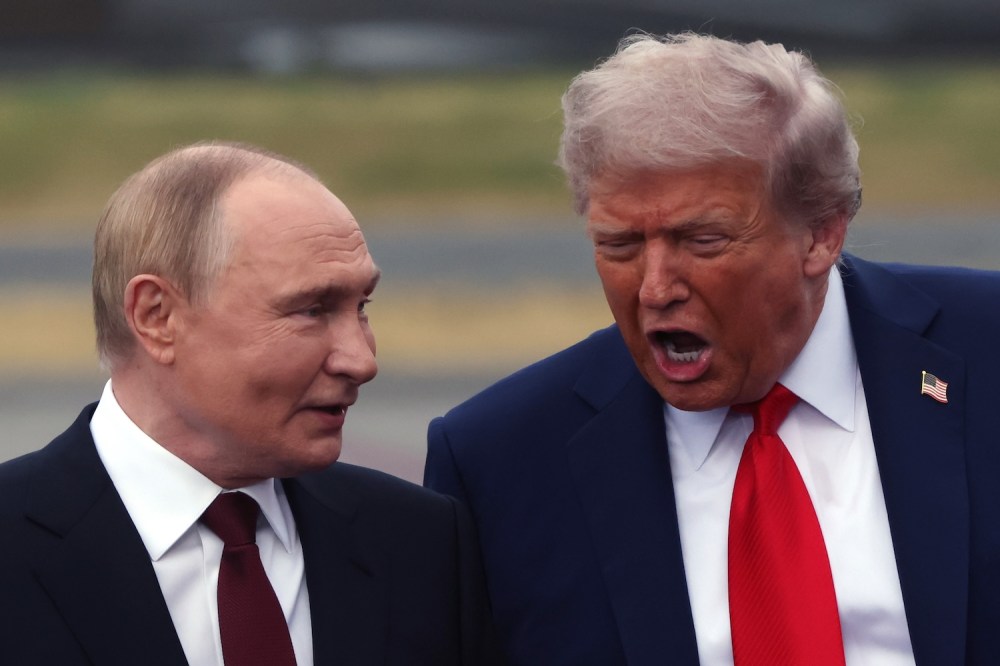After refusing to pressure Russia for nine months, U.S. President Donald Trump has finally unsheathed a sanctions weapon against the country’s all-important energy sector in a bid to starve Moscow’s war machine and bring it back to the negotiating table.
The U.S. sanctions, the first new ones of Trump’s second term, blacklisted Russia’s two largest oil companies—Rosneft and Lukoil—and most of their subsidiaries, and they have already spooked both of Russia’s main customers. Refiners in India and China said they would begin cutting oil trade with Russia in the wake of the U.S. sanctions. Coupled with fresh rounds of sanctions from the European Union (approved Wednesday) and the United Kingdom (announced earlier this month), the Western chokehold on Russia’s golden goose is finally taking devastating shape.
And while the Trump administration has given customers of Russian oil a month before the sanctions take effect, oil markets clearly believe that the hammer has dropped. Benchmark crude oil prices jumped 5 percent on Thursday, back to the mid-$60s a barrel, as the market expects at least some of the Russian barrels that formerly made their way to India and China will now be left unsold.
The question now is whether the concerted economic pressure—and increasing kinetic pressure from Ukraine on Russian energy and industrial assets—will be enough to coax Moscow back to the negotiating table that it seemingly just walked away from, or whether the Kremlin will try to brazen it out. Influential voices in Moscow, who believed that they had at least a nonhostile interlocutor in Trump, if not a friendly hand, are struggling to adjust to what seems to be, for now, a new reality.
The U.S. sanctions are a big deal for several reasons. First, while other countries (such as Britain) have directly targeted Rosneft and Lukoil and the EU has gone after other major Russian energy firms, nothing matches the reach and potential pain of the U.S. Treasury and the U.S. dollar when it comes to sanctions.
Second, instead of targeting end users—such as oil refiners—or intermediaries—including the hundreds of illicit vessels in Russia’s tanker fleet—the latest U.S. measures go straight at the source of half of Russia’s seaborne oil exports, as well as all their subsidiaries in oil exploration, research and development, and refining.
The implicit threat is U.S. secondary sanctions—any bank, company, port, or person who does business with any of the companies on that blacklist risks getting blacklisted themselves, which would immediately mean a loss of access to the international financial system. Some small Chinese banks and ports are air-gapped from the international system to do illicit trade with Iran and others, for example, but most big players in the energy business are plugged into the system for which the U.S. Treasury has an individualized kill switch.
“What was smart about what the administration did [was that] they didn’t go after specific refiners buying the oil—they went after these companies and their subsidiaries,” said Petras Katinas, an analyst at the Centre for Research on Energy and Clean Air, a Finland-based nonprofit. “These sanctions touch all Russian crude oil, by pipeline and by sea. Basically, all those companies that interact with Rosneft and Lukoil might be exposed” to sanctions themselves, he said.
The long reach of U.S. secondary sanctions became immediately apparent. Big state-owned refiners in China, Russia’s main customer for crude oil, said that they would wind down purchases as a result of U.S. sanctions. Granted, the bulk of Chinese imports of Russian oil come either through a pipeline that seems sanction-proof or via teapot refiners that have little exposure to the U.S. financial system. But a chunk of Russia’s China market seems to be drying up.
Ditto with India, with refiners there saying that they would begin to “recalibrate” their purchases of cheap Russian oil, a move that was already beginning to take shape in the wake of new U.S. tariffs on India announced in August due to its continued reliance on Russian crude.
Russia has, in the past, found ways to evade Western sanctions, such as through its large and still-growing “shadow fleet” of illicit tankers, which carry the bulk of its seaborne crude exports. China and India simply bought the stuff at a discount. Iran has been under maximum U.S. sanctions pressure for years, and yet its oil exports are as rosy as they have been in ages, at nearly 2 million barrels a day, thanks to evasive measures such as shadow fleets, ship-to-ship transfers, and dodgy intermediaries. But it’s unlikely that the volumes that Russia needs to export could pull off the same evasions tricks that Iran has managed to the same degree.
“China keeps importing Russian LNG [liquefied natural gas], so it shows the Iran model, a chain of supply where nothing can be touched by Western entities. But Russian crude oil—that is a huge volume to absorb via smuggling. There will be some big obstacles to absorb that volume of Russian oil,” Katinas said.
And the pressure is a one-two-three-four punch. On Wednesday, the EU overcame the usual political obstacles—in this case, a threatened veto by Slovakia—to pass its 19th Russian sanctions package, which blacklisted another couple of energy companies as well as more than 100 shadow fleet tankers, and sped up the end of Russia’s lucrative trade of liquefied natural gas to Europe.
Meanwhile, Ukraine continues its relentless assault on Russian oil refineries and fuel depots—the big Rosneft Ryazan refinery went up in flames overnight on Oct. 23—which limits Russia’s ability to refine oil and sell gasoline and diesel abroad, let alone fuel its military. And the United States has relaxed long-range targeting restrictions on weapons fielded by Ukraine, adding to the Ukrainian striking power against key industrial installations. Russia’s energy sector, in the fourth year of its war in Ukraine, is finally getting squeezed on all sides.
And it is not a healthy sector to begin with. During September, Russia earned the least from fossil fuel exports that it has in any month since the war began, and only half of what it was earning at the high point of late 2022. The three holdouts—or hopefuls, from Moscow’s point of view—are oil sales to Russia and China, oil product sales to Turkey, and natural gas sales to Europe. All three are targeted by the latest cocktail of U.S. and European sanctions.
And that added pressure comes at a time when the oil market is oversupplied, with many analysts (before the latest U.S. sanctions) expecting crude prices to keep dropping as supply outstrips demand well into next year. That was already going to be bad news for the Kremlin’s sorely strained budget; selling even less of the stuff will make a gloomy tale gloomier.
There remains the question: Why only now? The EU, the United Kingdom, and Ukraine have been asking for intensified U.S. sanctions pressure on Russia since January, to no avail, though they are well pleased now. The Trump administration long professed that tough sanctions on Moscow would make peace negotiations harder, not easier. Before the ill-fated Alaska summit between Trump and Russian President Vladimir Putin in August, there were even carrots of greater energy cooperation being brandished, not sticks.
One reason—Trump’s stated reason—is that he has lost patience with Putin following that humiliating Alaska meeting and the worsening prospects of anything more productive coming out of planned talks in Hungary. Russia has reiterated its maximalist demands, including the seizure of Ukrainian land that it doesn’t occupy and the neutering Ukraine’s ability to defend itself in the future, which Trump has realized does not yet provide the starting point for productive negotiations.
Another reason is that he can. For years, the Biden administration wrestled with how to strangle Russia’s energy sector without choking U.S. drivers to death with higher gasoline prices. But crude, thanks to months of OPEC supply increases, has been steadily getting cheaper, giving Trump the perfect amount of wiggle room to increase pressure on Russia and relieve some pressure on the price-sensitive U.S. oil patch.
Will it be enough to bring Putin back to the table? Russia’s fossil fuel earnings have already been cut in half, and it has not reached for any white flags. It has suffered at least 1 million casualties for little territorial gain, and it has yet to end its “special military operation.”
Putin has repeatedly told Trump that any agreement over Ukraine must address the “root causes” of the conflict, which are not, apparently, an unprovoked armored onslaught on a neighbor, but Ukraine’s very existence. The Russian Foreign Ministry spokesperson still talks of the need for the “denazification” of Ukraine, four years into the war, and former Russian President Dmitry Medvedev still talks of “Banderite Kiev”—a reference to Ukrainian anti-Soviet partisans in World War II.
What level of economic pressure on a subset of Russian state revenues will be enough to revolutionize Putin’s worldview?


